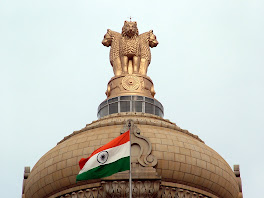
The Muslim identity of India is a thoroughly Indian identity, very different from the Islamic identity of other Muslim countries. This unique Indo-Islamic identity has evolved over centuries of intermingling of traditions, culture, religion and social contacts. The influence that practices of other religions had on the Islamic tradition, and vice-versa also led to the evolution of unique socio-religious traditions of the Muslims in India.
Indian Muslims draw their traditions from Arabs, Iranians, Turks, Afghans, Tajiks, Uzbeks, Abyssinians, and most of all from the traditions of the various regions of India. Indeed the Muslims of India, who are descendents of the original inhabitants of India for millennia, are as diverse as India itself.
By the 14th century when Turk kings ruled in the north, India had become a major center of Islamic learning. What Leonardo da Vinci represents to European renaissance, Amir Khusrou represents to Indian renaissance. In that period the major trend amongst the Muslims in India was to learn the philosophy, culture and tradition of India and to introduce the philosophy and culture of the Muslim world into India. Thus Khusrou was the pioneer in creating a new Indo-Islamic culture and tradition, and also a new language called Hindvi, the ancestor of today’s Hindi and Urdu.
Another major development in the Indo-Islamic ethos was in the area of architecture and technology. Ain-e-Akbari, the 16th century masterpiece gives ample evidence of Muslims’ having produced a variety of mechanical devices e.g. wagon mills, multi-barreled guns, screw cannons, and a variety of ingenuous machinery. Countless magnificent monuments and buildings all across India speak eloquently of the Muslims’ contribution to India’s distinct architecture. Muslims made major initiatives in the production of quality products like cosmetics, textiles, zari-work, metallurgy, glass and ceramics. Tipu Sultan is known to have developed rockets for use in his army against the expanding British campaign in India.
The development of irrigation, hydraulics and the construction of canals flourished as never before during the long Mogul reign. The harnessing of the principles of hydraulics and the use of devices such as deep wells, Persian wheel and artificial lakes, resulted in the development of the unique Mogul gardens. Large scale development of orchards and agricultural production was another enterprise of the Muslims.
Socially and culturally the greatest Muslim impact of the medieval era on India was through the Sufi movement which led to the growth of the Bhakti movement. The downfall of the Mogul empire after the first war of independence in 1857, saw Muslims of India go through a very traumatic period in which Muslims were subjected to much oppression by the new British rulers.
In the early decades of the 20th century growth of revolutionary and nationalistic literature occurred in the Muslim community. Slogans like “Inquilab Zindabad”, and songs like “Saaray jahan say acchha Hindostan hamaara”, and Allama Iqbal’s enthusiastic advocacy of the Indian nationalism are nuggets of India’s long freedom struggle whose origin lies in the Muslim community.
The partition of India in 1947 was a traumatic event for the Muslims of India, a majority of whom had taken active part in India’s freedom struggle under the leadership of Mahatma Gandhi, and did not want the partition. After 1947 with guidance from Maulana Abul Kalam Azad, Indian Muslims again started dedicating themselves to the building of the new nation, and to become active in various fields. After decades of struggling with this situation, Muslims are now well adjusted to the changed milieu of India.
Another important contribution of Muslims to the growth of the Indian culture is music and movies. Some of India’s top musicians of the 20th century, continuing on after 1947 are Muslims who contributed much to the substantial growth of genuine Hindustani vocal music, e.g. Khayal, Taraana, Dhrupad, Thumri, Qawwali, Ghazal, and musical instruments like Sitar, Sarod and Shehnai.
As the movie industry developed in India, Muslims took a leading role as actors/actresses, directors, producers, music-directors etc, putting Bollywood on the world stage of cinema.
In the last few decades India’s Muslims are again trying to re-invent the Aligarh Movement of the late 1800s and dedicate themselves to acquiring education. Although much remains to be done in this area, as the 21st century dawned, one could see the Muslim community in various parts of India, north, south, east, west, make a sincere effort to start educational institutions.
The recent emergence of APJ Abul Kalam, India’s top missile scientist; Azam Premji, a pioneer in the rapidly growing Information Technology industry; the internationally renowned painter MF Hussain; Sania Mirza the world class tennis player; many high achiever Muslims in Bollywood, as the as top leaders in their fields in India, is a testimony that Muslims in India are bouncing back to find their niche in the mains



1 comment:
Bollywood World Hot Bollywood Photos, bollywood film Photos, bollywood actors, photos of bollywood actors and actresses.
Post a Comment